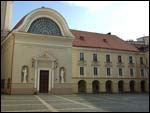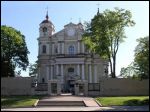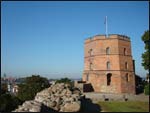History of Vilnius
Vilnius is the largest city and the capital of Lithuania, with a population of 555,613 as of 2008. It is the seat of the Vilnius city municipality and of the Vilnius district municipality. It is also the capital of Vilnius County.Vilnius is known by many derivate spelling in different languages throughout its history. Most notable non-Lithuanian names for the city include: Polish: Wilno, Belarusian: Вільня (Vilnia), Slovene: Vilna, German: Wilna, Latin: Vilna, Latvian: Viļņa, Russian: Вильнюс, Yiddish: ווילנע (Vilne). An older Russian name is Вильна / Вильно (Vilna/Vilno), although Vilnius is now used. The names Wilno and Vilna have also been used in older English and French language publications. The name Vilna is still used in Finnish and Hebrew languages.
Vilnius is situated in southeastern Lithuania (54В°41 N 25В°17 E) at the confluence of the Vilnia and Neris Rivers. It is believed that Vilnius, like many other cities, was named after a crossing river, Vilnia. Lying close to Vilnius is a site some claim to be the Geographical Centre of Europe.
Vilnius is a cosmopolitan city with diverse architecture. There are more than 40 churches in Vilnius. Restaurants, hotels and museums have sprouted since Lithuania declared independence. Like most medieval towns, Vilnius was developed around its Town Hall. The main artery, Pilies (Castle) Street, links the royal palace and the Town Hall. Other streets meander through the palaces of feudal lords and landlords, churches, shops and craftsmen's workrooms. Narrow, curved streets and intimate courtyards developed in the radial layout of medieval Vilnia.
The Old Town, the historical centre of Vilnius, is one of the largest in Europe. The buildings in the old town were built over several centuries, creating a splendid blend of many different architectural styles. Although Vilnius is known as a Baroque city, there are examples of Gothic, Renaissance, and other styles. The main sights of the city are High Castle and Cathedral Square, symbols of the capital. Their combination is also a gateway to the historic centre of the capital. Owing to its uniqueness, the Old Town of Vilnius was inscribed on the UNESCO World Heritage List in 1994.
The Vilnius (onwards - Vilnia, Vilna or Wilno as it was called in different periods) was first mentioned in written sources in 1323, in letters of Grand Duke Giedymin (lit. Gediminas) that were sent to German cities and invited Germans and members of the Jewish community to settle in the capital city. In 1387, the city was granted city rights by Jagiello (Jagaila, Jogaila), one of Giedymin' successors.
Between 1503 and 1522 the walls were built to protect the city, and at the time it had nine city gates and three towers. Vilnia reached the peak of its development under the reign of Sigismund August, who moved his court there in 1544. In the following centuries, it became a constantly growing and developing city. This growth was due in part to the establishment of the university by the King Stephen Bathory in 1579.
During its rapid development, the Vilnia was open to migrants from both abroad and far reaches of territories of Grand Duchy of Lithuania. Each group made its unique contribution to the life of the city, and crafts, trade and science prospered. During the Moscow-Polish War (1654–1667), Wilno was occupied by Moscow for several years. The city was pillaged and burned, and its population was massacred.
After the Third Partition of the Polish-Lithuanian Commonwealth in 15 April 1795, Wilno was annexed by Russian Empire. Following the November Uprising in 1831, University was closed and Russian repressions halted the further development of the city. During the January Uprising in 1863 heavy fighting occurred within the city, but was brutally pacified. After the uprising, all civil liberties were withdrawn, and use of the Polish, Belarusian and Lithuanian languages was banned. in early 20th century Lithuanian speaking population constituted only a small minority then, with Polish, Yiddish, and Belarusian speakers being most of the population of the city.
During World War I, Wilno was occupied by the German Empire from 1915 until 1918. The Act of Independence of Lithuania, that restored Lithuanian independence from any affiliation to any other nation was proclaimed in the city on February 16, 1918. On October 9, 1920 the so-called Polish-Belarusian Army under General Lucjan Żeligowski seized Wilno. The city and its surroundings were proclaimed as the separate state of Central Litva, that include a parts of territory of contemporary Lithuania and Belarus. On February 20, 1922 after an elections, the whole area was attached to Poland, with the city as the capital of the Wilno Voivodship.
In the meantime, for yet another time in its history, the city enjoyed a period of fast development. Wilno University was reopened under the name Stefan Batory University and the city's infrastructure was improved significantly. By 1931, the city had 195,000 inhabitants.
Following the secret protocol of the Molotov-Ribbentrop Pact, on September 19, 1939, Wilno was seized and annexed by the Soviet Union. There were plans to include the city and the region as a part of the Belarusian Soviet Republic (most of inhabitants of the villages around the Wilno were Belarusians), but eventually it was decided that the city might be used as a way to exert significant influence on Lithuania. On October 10, 1939, after a Soviet ultimatum, the Lithuanian government accepted the presence of Soviet military bases in various parts of the country in exchange for restoring the Vilnius to Lithuania. Though the process of transferring the capital from Kaunas to Vilnius was encouraged by Soviet emissaries initiated soon after, and the whole of Lithuania was annexed by the Soviet Union in June 1940. An illegitimate Soviet government was installed, with Vilnius as the capital of the newly created Lithuanian Soviet Republic. Up to 40,000 of the city's inhabitants were arrested by the NKVD and sent to gulags in the far eastern areas of the Soviet Union.
In June 1941, the city was occupied by Germany. Two ghettos were set up in the old town center for the large Jewish population. During the Holocaust about 95% of the 265,000-strong Jewish population of Lithuania was murdered. In July 1944 Vilnius was taken from the Germans by the Soviet Army and the Polish Armia Krajowa. Vilnius was again incorporated into the Soviet Union as the capital of the Lithuanian Soviet Republic shortly thereafter. The majority of the remaining Polish population was compelled to relocate to the Poland in 1946, and the city was inhabited by Lithuanians and Russians.
On March 11, 1990, the Supreme Council of the Lithuanian Soviet Republic announced its independence from the Soviet Union and restored the independent Republic of Lithuania. The Soviets responded on January 9, 1991, by sending in troops. On January 13 during the Soviet Army attack at least fourteen civilians were killed and more than 700 were seriously injured. The Soviet Union finally recognized Lithuanian independence in August 1991.
Vilnius has been rapidly transformed and the town has emerged as a modern European city. Many of its older buildings have been renovated, and a business and commercial area is being developed into the New City Center, expected to become the city's main administrative and business district on the north side of the Neris river.
Vilnius is the Roman Catholic center of the Lithuania, with the main church institutions and Archdiocesan Cathedral located here. Additionally, Eastern Rite Catholicism has maintained a presence in Vilnius since the Union of Brest. Also, Vilnius has been home to an Eastern Orthodox Christian presence since the 13th or even the 12th century. Many Old Believers, who split from the Russian Orthodox Church in 1667, settled in Lithuania. A number of Protestant and other Christian groups are represented in Vilnius, most notably the Lutheran Evangelicals and the Baptists.
Once widely known as Yerushalayim De Lita (the "Jerusalem of Lithuania"), Vilna since the 18th century was comparable only to Jerusalem, Israel, as a world center for the study of the Torah, and for its large Jewish population. That is why one part of Vilnius was named Jeruzalė. At the end of the 19th century, the number of synagogues in Vilna exceeded one hundred. A major scholar of Judaism and Kabbalah centered in Vilna was the famous Rabbi Eliyahu Kremer, also known as the Vilna Gaon. His students have significant influence among Orthodox Jews in Israel and around the globe. Jewish life in Vilna was destroyed during the Holocaust; there is a memorial stone dedicated to victims of Nazi genocide located in the center of the former Jewish Ghetto — now Mėsinių Street.
According to:
Vilnius - Wikipedia, the free encyclopedia,
http://en.wikipedia.org/wiki/Vilnius
Vilnius. : Places of interest | selected photos
 Gate of Dawn
Gate of Dawn
Interior of Vostraja Brama chapel. Drawing from the middle of XIX century
 Orthodox church of the Holy Trinity and the monastery of Basilians (Uniate)
Orthodox church of the Holy Trinity and the monastery of Basilians (Uniate)
The monastery of Basilians in Vilnius
 Catholic church of the Holy Spirit and the Dominican Monastery
Catholic church of the Holy Spirit and the Dominican Monastery
View at the church from North-East
 Catholic church of St. Casimir and the Monastery of Jesuits
Catholic church of St. Casimir and the Monastery of Jesuits
St. Casimir church in Vilnius
 Catholic church of St. John the Baptist and St. Jonh the Apostle and Evangelist
Catholic church of St. John the Baptist and St. Jonh the Apostle and Evangelist
Main facade, belfry and the gate of the University
 Vilnius University
Vilnius University
The Piotr Skarga (or Great) courtyard with the entry into University, fragment
 Catholic church of the Assumption of the Blessed Virgin Mary and the Monastery of Franciscan
Catholic church of the Assumption of the Blessed Virgin Mary and the Monastery of Franciscan
Main facade of the church and fragment of the monastery
 Catholic church of St. Theresa (of the Carmelites)
Catholic church of St. Theresa (of the Carmelites)
Church of St. Theresa and the Chapel of the Vastrabramskaja Mother of Mercy
Vilnius. : Lost heritage | Photo

Vilnius. Catholic church of the Sacred Heart of Jesus (1913-1916, 1920-x) Photo © Анатолий, http://vilnius.fastbb.ru
Comments
Czy jest prawdziwa informacja, że w 1772 roku pałac ten kupił płk J. Nahurski i skąd tablica z herbem Nagurskich a nie Nahurskich....
Здравствуйте, являюсь прихожанином этого прихода. Хочу спросить - возможно ли получить эти фотографии (церкви Архангела Михаила) в лучшем качестве, - на память.
Поясню - в храме был сделан ремонт и заменен иконостас, многое было изменено и даже утрачено.
Подобных фотографий нигде нет, они в своём роде уникальные.
Можно ли связаться с автором?...
Szukam Mojej 94 letniej Mamy bliskiej rodziny ...
http://nieobecni.com.pl/index.php?s=szukaj&imie=Anton+&nazwisko=Schmid&x=27&y=5...
Czy ktoś wie co się teraz tam mieści? Czy można wejść do środka?...







